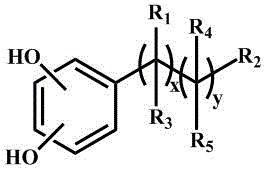Decolorization treatment method for colored liquid waste
A treatment method and technology for colored waste liquid, applied in the field of catalytic decolorization of colored waste liquid, can solve the problems of difficult dispersion, membrane pollution cost, cumbersome pretreatment process, etc., and achieve low cost, high catalytic effect, and high controllability of operation. Effect
- Summary
- Abstract
- Description
- Claims
- Application Information
AI Technical Summary
Problems solved by technology
Method used
Image
Examples
Embodiment 1
[0036] 1g of montmorillonite-loaded silver nanoparticle catalyst (containing 90% montmorillonite, 8% polydopamine and 2% silver nanoparticles) was granulated and packed into a packed column, and a mixed solution of reducing agent sodium borohydride and methylene blue (mass After the ratio of 0.1:1), the column treatment is carried out, and the required decolorization time is 10 minutes. After using more than 50 times, the decolorization rate reaches more than 95%. Use an aqueous solution containing acetone for rinsing, and the packed column recovers its decolorization ability after rinsing.
Embodiment 2-6
[0038] 1g of talcum powder-loaded platinum nanoparticle catalyst (containing 75% talc powder, 5% 3,4-dihydroxybenzylamine and 20% platinum nanoparticles) was granulated and loaded into a packed column, and the reducing agent hydrazine hydrate or After ascorbic acid or polyol or formaldehyde or a mixed solvent of formic acid and methylene blue (mass ratio 10:1), the column is processed, and the required decolorization time is 10 seconds. After more than 50 times of use, the decolorization rate reaches more than 95%. Use an aqueous solution containing 20% isopropanol for rinsing. After rinsing, the packed column recovers its decolorization ability.
Embodiment 7-12
[0040] 1g of montmorillonite-supported silver nanoparticle catalyst (containing 90% montmorillonite, 8% polydopamine and 2% silver nanoparticles) is granulated and loaded into a packed column, and the reducing agent sodium borohydride and pharmaceutical or papermaking or printing and dyeing are added Or ceramic or leather or chemical mixed solvent colored wastewater (mass ratio 1:1000) is treated with solid packed bed. The required decolorization time is 1 minute. After more than 100 times of use, the decolorization rate reaches more than 95%. Ethanol-containing aqueous solution is used for rinsing, and the packed column recovers the decolorization ability after rinsing.
PUM
 Login to View More
Login to View More Abstract
Description
Claims
Application Information
 Login to View More
Login to View More - R&D
- Intellectual Property
- Life Sciences
- Materials
- Tech Scout
- Unparalleled Data Quality
- Higher Quality Content
- 60% Fewer Hallucinations
Browse by: Latest US Patents, China's latest patents, Technical Efficacy Thesaurus, Application Domain, Technology Topic, Popular Technical Reports.
© 2025 PatSnap. All rights reserved.Legal|Privacy policy|Modern Slavery Act Transparency Statement|Sitemap|About US| Contact US: help@patsnap.com



